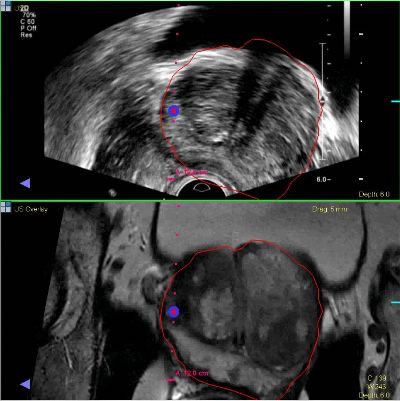New technology improves prostate cancer biopsies
Media contact: Nicole Fawcett, 734-764-2220 | Patients may contact Cancer AnswerLine™, 800-865-1125
U-M specialists combine new techniques to better diagnose cancer, target the right treatment
ANN ARBOR, Mich. — The goal is not to find every prostate cancer – it’s to find aggressive prostate cancer that may impact a man’s survival.

Prostate cancer specialists at the University of Michigan Rogel Cancer Center are refining prostate cancer diagnosis to better identify those cancers that are more likely to grow quickly and spread to other parts of the body.
The University of Michigan is the first in the region to offer men a new technology that combines MRI and real-time ultrasound to help guide a biopsy needle, ensuring that tissue from all suspicious areas is captured.
“Standard prostate biopsies are random. We systematically obtain random samplings from the prostate, but there’s no guarantee that a biopsy will hit the cancer,” says Ganesh Palapattu, M.D., associate professor of urology and chief of urologic oncology at the University of Michigan Rogel Cancer Center.
Palapattu compares it to shooting fish in a barrel with your eyes blindfolded. The new technology, called UroNav, is like taking the blindfold off.
UroNav allows urologists to know where a suspicious lesion is so that a biopsy needle can be targeted more precisely. In addition, the system can store the trajectory of needles so that repeated biopsies can sample the same area. U-M specialists have been using a similar system for research studies for nearly two years.
The technology is most useful for:
- men with a concerning prostate MRI
- men considering or currently under active surveillance for prostate cancer
- men with an elevated PSA or other concern for prostate cancer
MRI is primarily used to identify potential sites of prostate cancer when the standard workup does not identify disease – for example, a negative biopsy but a rising PSA.
“MRI has only become useful in prostate cancer diagnosis over the last several years. Advanced MRI technique, which we use extensively at the University of Michigan, allows us to identify and target clinically significant prostate cancers. One of the nice side effects is that modern MRI tends to minimize the appearance of non-aggressive prostate cancers. So it really refines our ability to find the kind of cancer we want to find,” says Matthew Davenport, M.D., assistant professor of radiology at the U-M Medical School.
In addition to using MRI to help visualize the prostate, U-M urologists are also able to use newer markers combined with PSA to better gauge the risk of aggressive prostate cancer. A new test developed at the University of Michigan called Mi-Prostate Score combines PSA along with a marker called PCA3 and a genetic anomaly discovered in U-M labs that’s present in half of all prostate cancers. The combined test score gives a more accurate assessment of whether a man has aggressive prostate cancer.
“PSA has been criticized as a poor marker for prostate cancer. We’re developing advances in prostate cancer diagnosis that go beyond just an elevated PSA. A PSA test may be part of the picture, but it’s no longer all we have available,” says Jeffrey Montgomery, M.D., assistant professor of urology at the U-M Medical School.
Some 239,000 men are diagnosed with prostate cancer each year. Most men will die with prostate cancer, not from it, because their disease is slow-growing. But a subset of patients will develop fast-growing cancers that require immediate and aggressive treatment. The challenge is reliably identifying which type of cancer a patient has.
"While prostate cancer may look the same from one patient to the next under a microscope, it may behave quite differently. This kind of behavior is driven largely by the genetics, the DNA sequencing of the cancer. The more information we can learn about a tumor – through better biopsies and better diagnostic tests – the more we will be able to tailor therapy for a patient. Our goal is to offer individualized treatment plans focused on each patient," Palapattu says.
Patients: For more information about prostate MRI, MR-ultrasound fusion biopsy (UroNav), Mi-Prostate Score or prostate cancer care at the University of Michigan, call the Cancer AnswerLine™ nurses at 800-865-1125.
